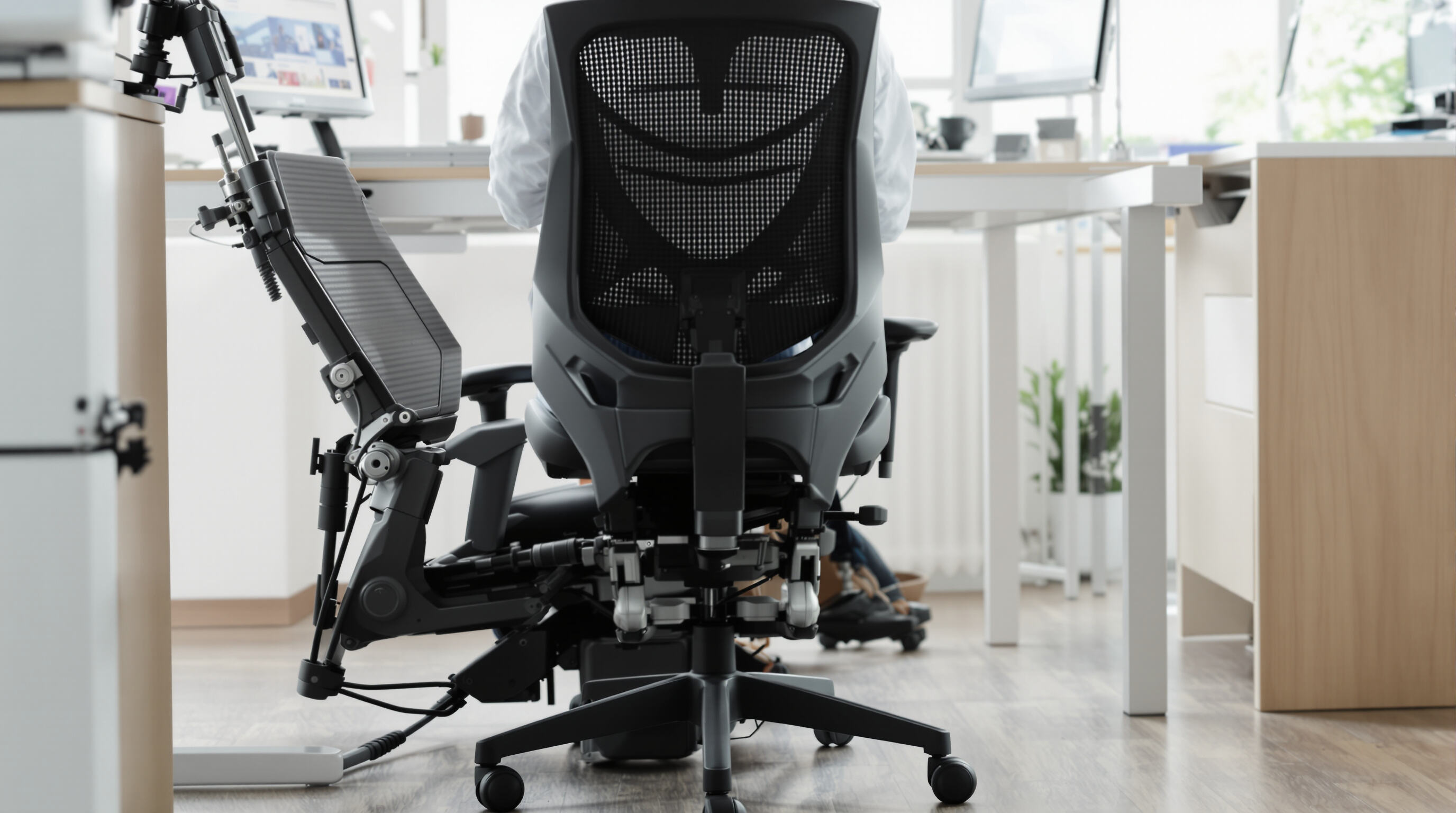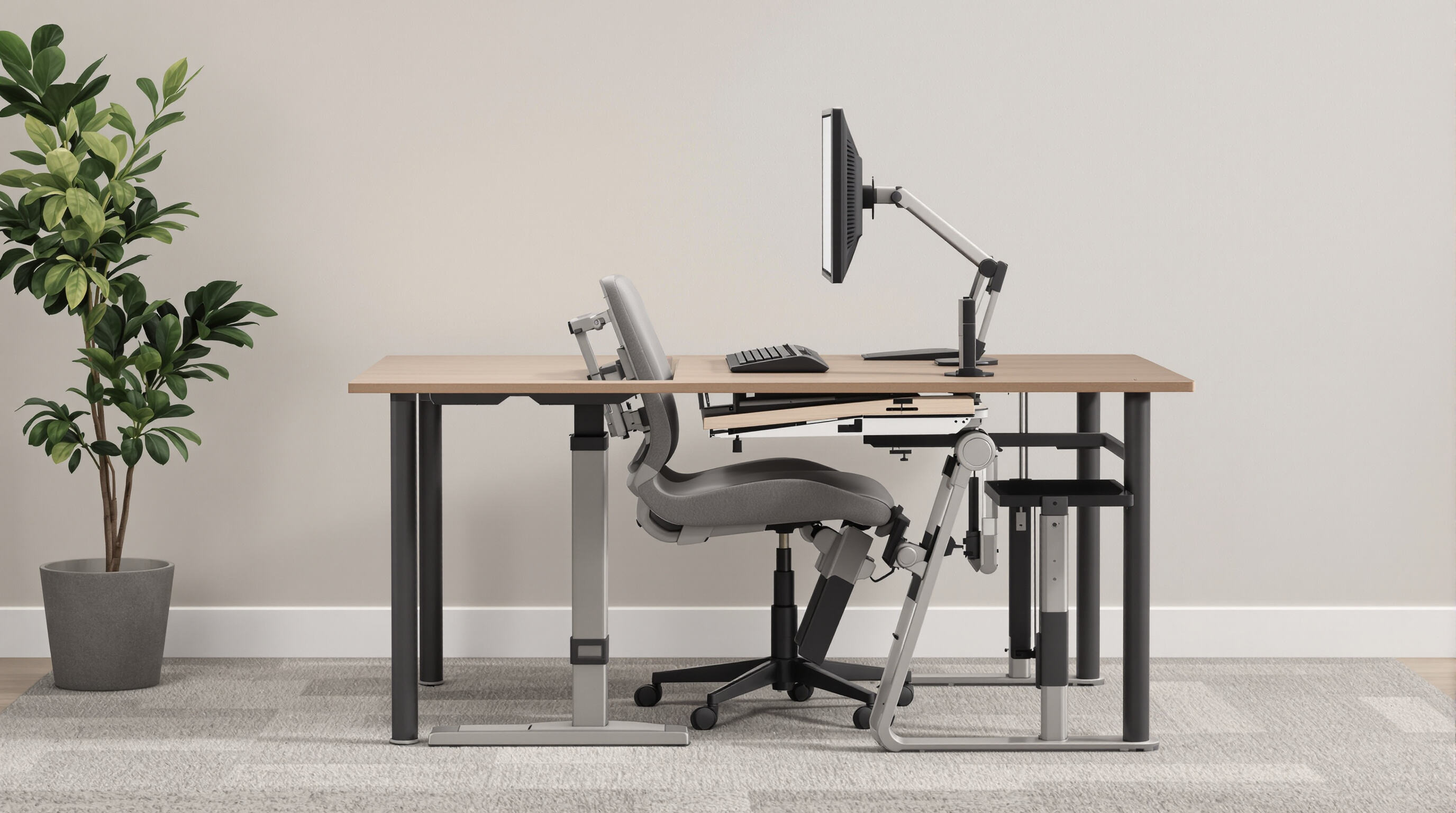Chair Height and Seat Depth: Foundation for Proper Posture and Circulation

How Seat Height Affects Posture, Leg Circulation, and Screen Alignment
Getting the chair height right makes all the difference for keeping the spine aligned properly, ensuring good blood flow in the legs, and setting up the computer screen correctly. Studies show that sitting with about 90 degree angles at both knees and elbows cuts down on muscle and bone pain by around 34% when compared to bad seating arrangements. The feet need to touch the ground or sit comfortably on something like a footrest to keep blood flowing normally through the lower body. At the same time, eyes should be level with roughly the upper part of whatever screen we're looking at, which helps prevent those annoying neck aches that come from staring down too long.
| Adjustment Metric | Optimal Range | Purpose |
|---|---|---|
| Seat Height | 16"-21" | Keeps knees at 90°-110° |
| Seat Depth | 17"-20" | Prevents popliteal (behind-knee) pressure |
Finding the Optimal Seat Depth to Prevent Knee Pressure and Support Thighs
The depth of a seat plays a big role in how weight gets distributed across the thighs, which helps keep blood flowing properly behind the knees instead of getting cut off. Some research from last year showed interesting results when people kept about two to four fingers worth of space between their seat edge and the back of their knees. Lower back pain went down for around seven out of ten participants in that experiment. When seats go beyond twenty inches deep, folks tend to slump forward instead of sitting up straight. On the flip side, anything shorter than seventeen inches puts too much pressure right on the thighs, making sitting uncomfortable after just a few hours at work or driving long distances.
Step-by-Step Guide to Adjusting Height and Depth for Personalized Fit
- Initial Setup: Sit fully back in the chair with feet flat on the floor.
- Height Check: Adjust the seat so your thighs are parallel to the ground and knees are at 90°–110°.
- Depth Test: Slide the seat forward or back until 2–4 inches remain between the edge and the back of your knees.
- Final Validation: Confirm your back maintains contact with lumbar support while typing.
Chairs with sliding bases or tilt mechanisms accommodate users between 5'2" and 6'3". For shared workstations, models with memory foam or synchronized recline offer better adaptability across body types.
Lumbar and Backrest Adjustments: Supporting the Natural Spine Curve
Why lumbar support is critical for maintaining lower back health
Good lumbar support helps maintain the spine's natural S shape, which can cut down on disc pressure by around 35% when compared with those flat backed office chairs we all know too well, as reported in some recent ergonomic studies from The New York Times back in 2025. When there's no adequate support for the lower back area, what happens is the spine tends to flatten out. This makes the surrounding muscles work harder than they should, and it explains why so many people sitting at desks day after day end up dealing with ongoing lower back issues. About 41 percent of these desk jockeys actually suffer from chronic discomfort in their lower backs. That's quite a number! For adjustable lumbar supports to really work properly, they need to fit both vertically and horizontally across the seat surface. Getting rid of those annoying gaps between the chair and the body ensures better overall support throughout the day and spreads out the weight more evenly instead of concentrating it all in one spot.
Adjusting backrest angle to reduce spinal load during prolonged sitting
When the office chair backrest is adjusted to around 100 to 110 degrees from straight up, something interesting happens. According to ScienceDirect research from 2025, this position actually cuts down on spinal pressure by nearly 30 percent as body weight shifts onto the backrest instead of pressing down on the spine. The angle works wonders for keeping the spine in good shape while also letting people see their computer screens without straining their necks. Great news for anyone who sits at desks for six hours or more every day. To get the most out of this setup, adjust those tension settings so the chair moves smoothly when leaning back but still keeps the lower back supported properly. This helps avoid that annoying slump where the body slides forward and puts extra stress on the spine's ligaments.
Dynamic recline vs. fixed positions: Enhancing comfort through micro-movements
People sitting in fixed back chairs tend to feel their muscles tire out about 22% faster after just two hours compared with those using dynamic seating options. Better quality office chairs typically allow for around 4 to 8 degrees of gentle recline which lets users shift positions slightly while still maintaining good lower back support. When paired with regular stand ups every hour or so, these small adjustments help engage core muscles and get blood flowing better throughout the body. This combination works wonders particularly when someone spends long stretches at a computer screen working on code or graphic designs all day long.
Armrest Configuration: Reducing Shoulder and Neck Strain
Optimal Armrest Height and Position for Neutral Shoulder Alignment
Correct armrest height keeps shoulders relaxed and elbows at 90° when typing, with forearms parallel to the floor. A 2023 ergonomics study found that improper settings increase trapezius muscle strain by 37% over an 8-hour workday. Proper alignment prevents slouching and reduces fatigue in the neck and upper back.
Evaluating Padding, Width, and Adjustability (Including 4D Armrests)
Key factors in armrest design include:
- Padding: 1.2"–1.5" thickness offers optimal balance of comfort and structural support
- Width: 6"–8" between armrests fits 95% of users (Anthropometric Data Consortium 2022)
- Adjustability: 4D armrests (height, width, pivot, depth) reduce wrist extension by 53% compared to fixed models
For users spending more than 6 hours daily at a computer, 4D adjustability allows frequent micro-adjustments, distributing pressure across the elbows and forearms and reducing the risks of static posture.
Seat Material and Build: Enhancing Comfort During Extended Use
Breathable fabrics and foam density for temperature and pressure management
Materials that let air flow through them, such as those fancy meshes we see these days, cut down on heat accumulation around 40 percent when compared to regular old fabric seats according to Ergonomics International from last year. This makes all the difference when someone needs to stay focused while sitting at their desk for hours on end. Then there's this high density foam stuff rated between 1.8 and 2.5 pounds per cubic foot that spreads out body weight better. Some chairs even have different densities in various areas which helps take pressure off sensitive spots by about thirty percent based on some studies published in the Journal of Occupational Health back in 2021. And don't forget about those temperature controlling fabrics paired with shaped bottoms that keep sweat at bay. People actually stick with tasks 27% longer when they're sitting comfortably in climate controlled environments according to recent workplace surveys, so it really does matter for productivity.
Comparing mesh, cushioned, and hybrid seat designs for long-term comfort
Chairs with mesh backs let air flow through much better than regular padded ones actually do, around 65% more airflow according to tests, but they need stronger borders so people don't end up sinking into them like hammocks. Padded seats made with memory foam or gel feel more comfortable at first glance, scoring about 22% better on comfort scales, although many folks find themselves getting hot after sitting there for almost an hour and a half straight. These days we're seeing hybrid options become pretty popular too. They mix breathable mesh with quality leather that has holes in it. Such combinations account for nearly half of all high end office chairs sold last year per the latest furniture ergonomics study from 2023. The combination works well because it keeps things cool while still providing good back support, which makes sense for workers who alternate between deep concentration periods and team meetings throughout their day.
Integrating Computer Chair Adjustments with Desk and Monitor Setup

A properly adjusted chair anchors an ergonomic workstation when aligned with desk and monitor placement. Research shows 74% of screen-related musculoskeletal disorders stem from mismatched chair and desk setups (Occupational Health Journal, 2023). Coordinating these elements maximizes comfort and productivity during extended computer use.
Aligning Chair Settings with Ergonomic Workstation Principles
Set chair height so your feet rest flat and thighs are parallel to the floor. Adjust armrests to keep elbows at 90° and shoulders relaxed. This dual adjustment promotes neutral posture and aligns with ergonomic standards for spinal health and weight distribution.
How Monitor Height and Keyboard Placement Affect Chair Positioning
The height of the monitor really affects how we adjust our chairs. When the top of the screen is about 2 to 4 inches below where our eyes naturally look, we usually need to raise the seat just a bit so our heads stay in a comfortable position. What about keyboards? Their placement tells us where to set those armrests. If the keyboard is sitting roughly 1 or 2 inches above the thighs when placed on a desk or tray surface, then the armrests need to hold up those forearms without making the shoulders lift up. Getting these settings right helps avoid that forward slouch everyone gets into at their desks, which puts unnecessary strain on both neck and shoulder muscles over time.
Full-Body Alignment Checklist to Prevent Neck, Back, and Wrist Strain
- Eyes: Screen center positioned 15–30° below horizontal sightline
- Neck: Monitor within 20–30" distance to avoid forward head tilt
- Back: Lumbar support maintaining natural S-curve spinal alignment
- Arms: Keyboard and mouse at elbow height with wrists straight
- Legs: 2–3 finger widths between seat edge and back of knees
This integrated approach creates a feedback loop: chair adjustments inform monitor and desk setup, and vice versa. Regular micro-adjustments throughout the day help sustain optimal alignment as your body shifts naturally.
FAQ
Why is chair height important for posture?
Chair height affects the alignment of knees and elbows, which influences spine alignment and circulation. A proper chair height allows the feet to rest flat on the ground, maintaining a 90–110 degree knee angle, which is crucial for posture and preventing muscle and bone strain.
How should I adjust my seat depth?
Adjust the seat depth so there are 2–4 inches between the edge of the seat and the back of your knees. This prevents pressure on the thighs and helps maintain proper circulation and sitting posture.
What is the significance of lumbar support in an office chair?
Lumbar support helps maintain the spine's natural S-curve and reduces disc pressure. Proper lumbar support is essential for preventing lower back pain and discomfort, especially during extended periods of sitting.
How do armrests affect my sitting posture?
Proper armrest height keeps shoulders relaxed and elbows at a 90-degree angle, reducing muscle strain and fatigue. Adjustable armrests can also help distribute pressure evenly across the elbows and forearms, minimizing the risk of static posture.
Table of Contents
- Chair Height and Seat Depth: Foundation for Proper Posture and Circulation
- Lumbar and Backrest Adjustments: Supporting the Natural Spine Curve
- Armrest Configuration: Reducing Shoulder and Neck Strain
- Seat Material and Build: Enhancing Comfort During Extended Use
- Integrating Computer Chair Adjustments with Desk and Monitor Setup
- FAQ

